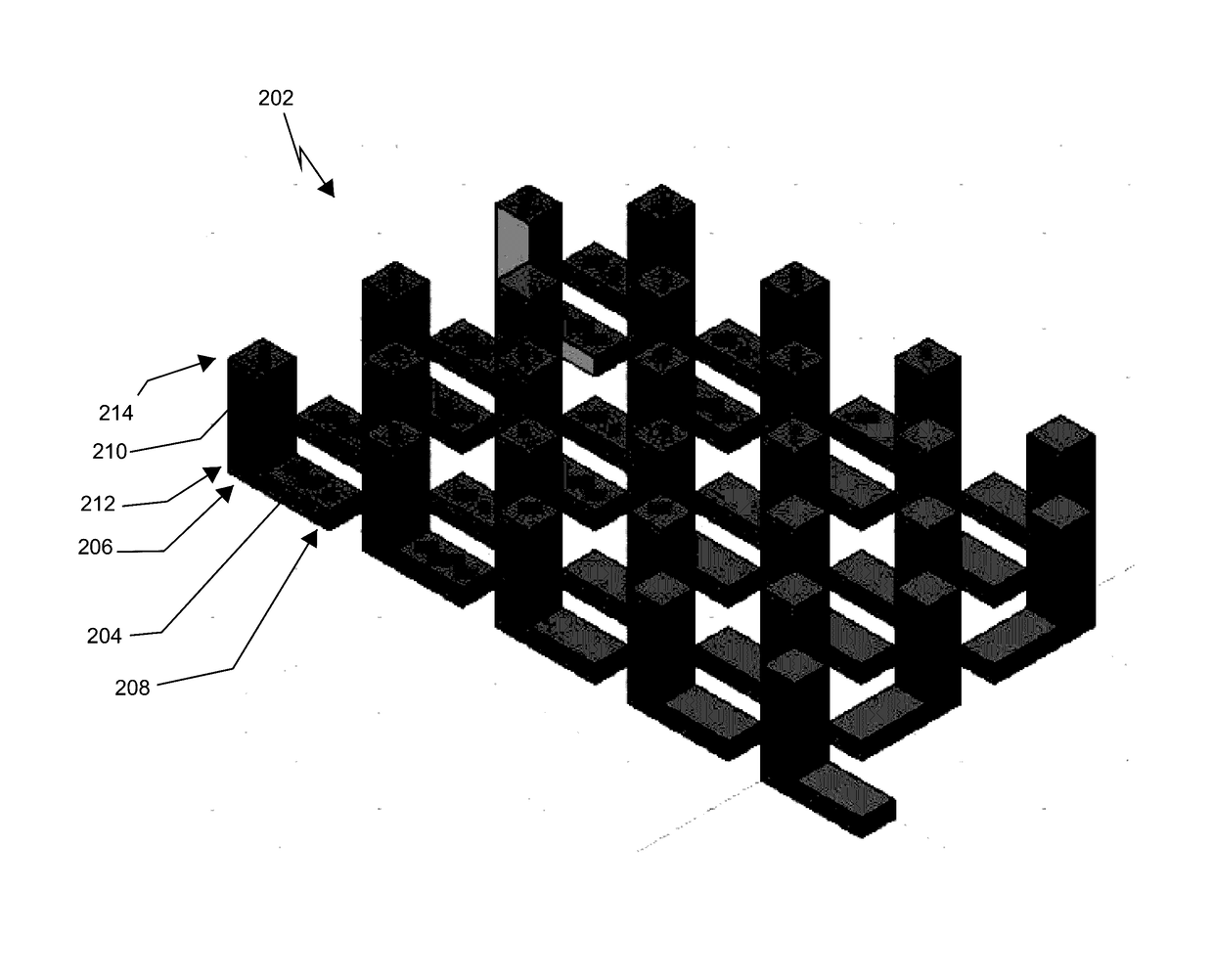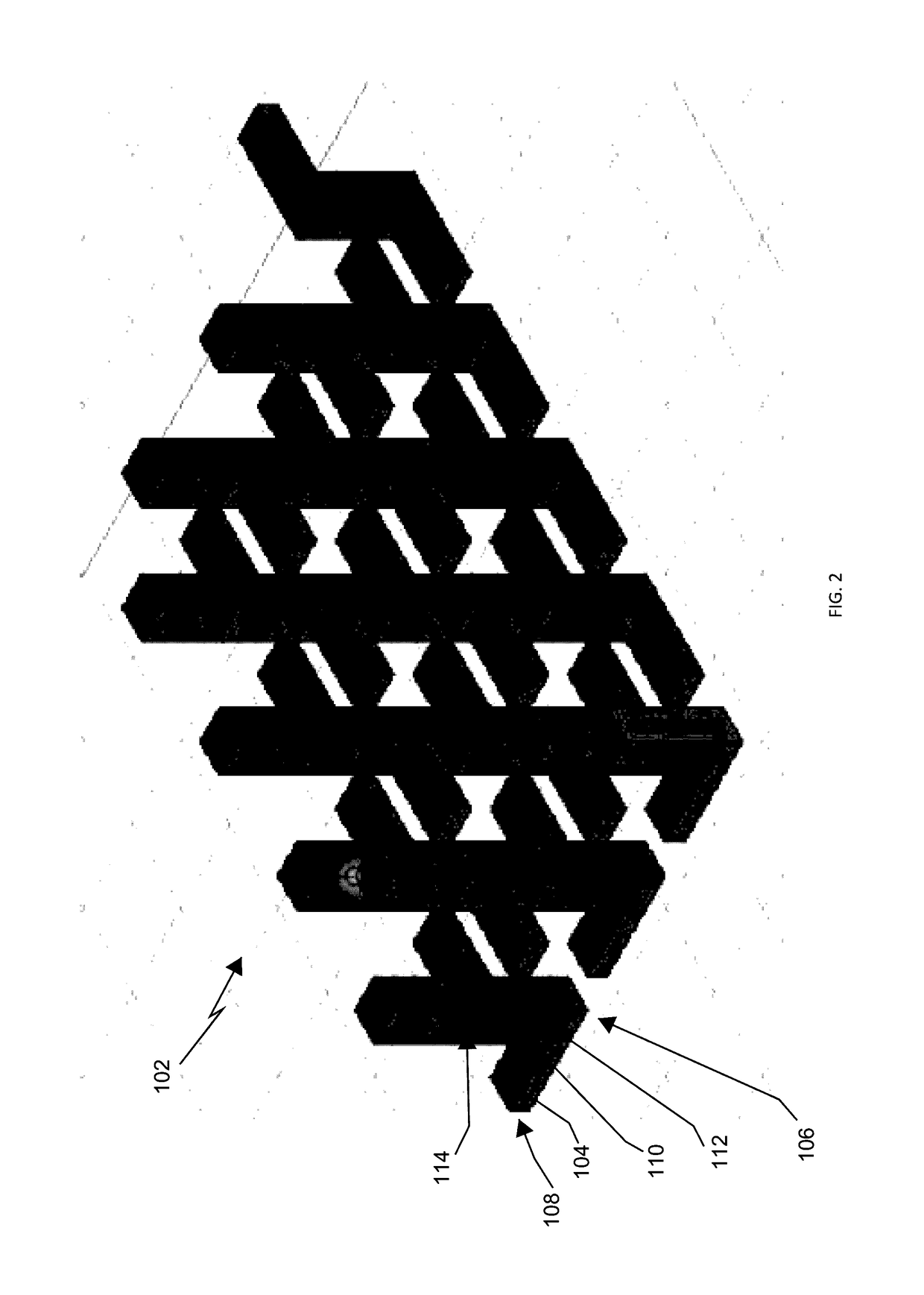Thermoelectric Devices
a technology of thermoelectric devices and thermoelectric devices, which is applied in the field of additive manufacturing, can solve the problems of reducing reliability and reproducibility, degrading the performance of useful devices, and costing and complexity of assembling useful devices which incorporate, so as to achieve greater manufacturing speed and reduce manufacturing costs
- Summary
- Abstract
- Description
- Claims
- Application Information
AI Technical Summary
Benefits of technology
Problems solved by technology
Method used
Image
Examples
example 1
[0041]In one embodiment, a sheet of the non-conducting polyimide Kapton® substrate 100 of the appropriate thickness was affixed to the build plate of a commercial stereolithographic printer (Ember from Autodesk, San Francisco, Calif.). An electrically-conducting photopolymer resin was prepared by mixing together about 65% to about 75% of Photomer 4050 (PEG 200 diactylate, IGM Resins, St. Charles, Ill.), about 15% to about 25% of SR494 from Sartomer Americas (ethoxylated pentaerythritol tetraacrylate, Exton, Pa.), about 2.0 weight % of BAPO (phenylbis(2,4,6-trimethylbenzoyl)phosphine oxide), IGM Resins, Charlotte, N.C.), and about 40 mg of single-walled carbon nanotubes (SWCNT) obtained from OCSiAl (Palo Alto, Calif.), and doped with p-type material to obtain about 50 mL of an electrically-conducting p-type photocurable resin. Preferably, Photomer 4050 is about 73% of the total resin. The resin was dispersed by power sonication with a Branson (Danbury, Conn.) Digital Sonifier model 2...
example 2
[0044]In another embodiment, a prototype thermoelectric generator was fabricated by first preparing an electrically non-conducting acrylate resin by mixing together about 65% to about 75% of Photomer 4050 (PEG 200 diacrylate, IGM Resins, St. Charles, Ill.), about 15% to about 25% of SR494 from Sartomer Americas (ethoxylated pentaerythritol tetraacrylate, Exton, Pa.), about 2.0 weight % of BAPO (phenylbis(2,4,6-trimethylbenzoyl)phosphine oxide), IGM Resins, Charlotte, N.C.), and agitated for 24 hours using a magnetic stirrer to obtain about 50 mL of resin. Preferably, the Photomer is about 73% of the total resin. The non-conducting substrate layer 100 of an arbitrary size was printed onto the build plate of a commercial stereolithographic printer (Ember from Autodesk, San Francisco, Calif.). An electrically-conducting photopolymer resin was prepared by mixing together about 65% to about 75% of Photomer 4050 (PEG 200 diacrylate, KAI Resins, St. Charles, Ill.), about 15% to about 25% o...
example 3
[0046]In another embodiment, a prototype thermoelectric generator was fabricated by first preparing an electrically non-conducting photopolymer resin by mixing together about 65% to about 75% of Photomer 4050 (PEG 200 diacrylate, IGM Resins, St. Charles, Ill.) about 15% to about 25% of SR494 from Sartomer Americas (ethoxylated pentaerythritol tetraacrylate, Exton, Pa.), about 2.0 weight % of BAPO (phenylbis(2,4,6-trimethylbenzoyl)phosphine oxide), IGM Resins, Charlotte, N.C.), and agitated for 24 hours using a magnetic stirrer to obtain about 50 mL of resin. Preferably, the Photomer was about 73% of the total resin. The non-conducting substrate layer 100 of an arbitrary size was printed onto the build plate of a commercial stereolithographic printer (Ember from Autodesk, San Francisco, Calif.). An electrically-conducting photopolymer resin was prepared by mixing together about 65% to about 75% of Photomer 4050 (PEG 200 diacrylate, IGM Resins, St. Charles, Ill.), about 15% to about 2...
PUM
 Login to View More
Login to View More Abstract
Description
Claims
Application Information
 Login to View More
Login to View More - R&D
- Intellectual Property
- Life Sciences
- Materials
- Tech Scout
- Unparalleled Data Quality
- Higher Quality Content
- 60% Fewer Hallucinations
Browse by: Latest US Patents, China's latest patents, Technical Efficacy Thesaurus, Application Domain, Technology Topic, Popular Technical Reports.
© 2025 PatSnap. All rights reserved.Legal|Privacy policy|Modern Slavery Act Transparency Statement|Sitemap|About US| Contact US: help@patsnap.com



